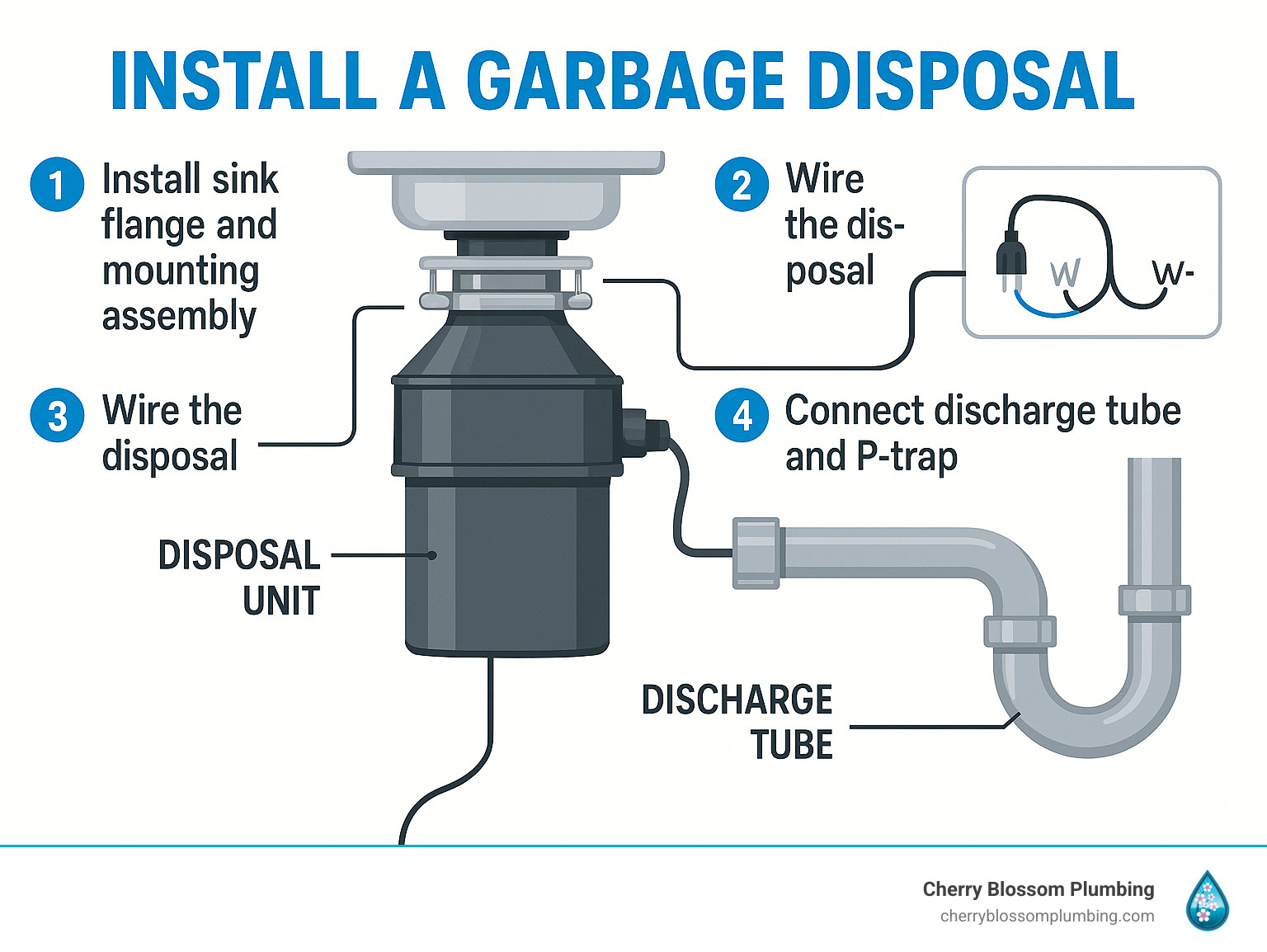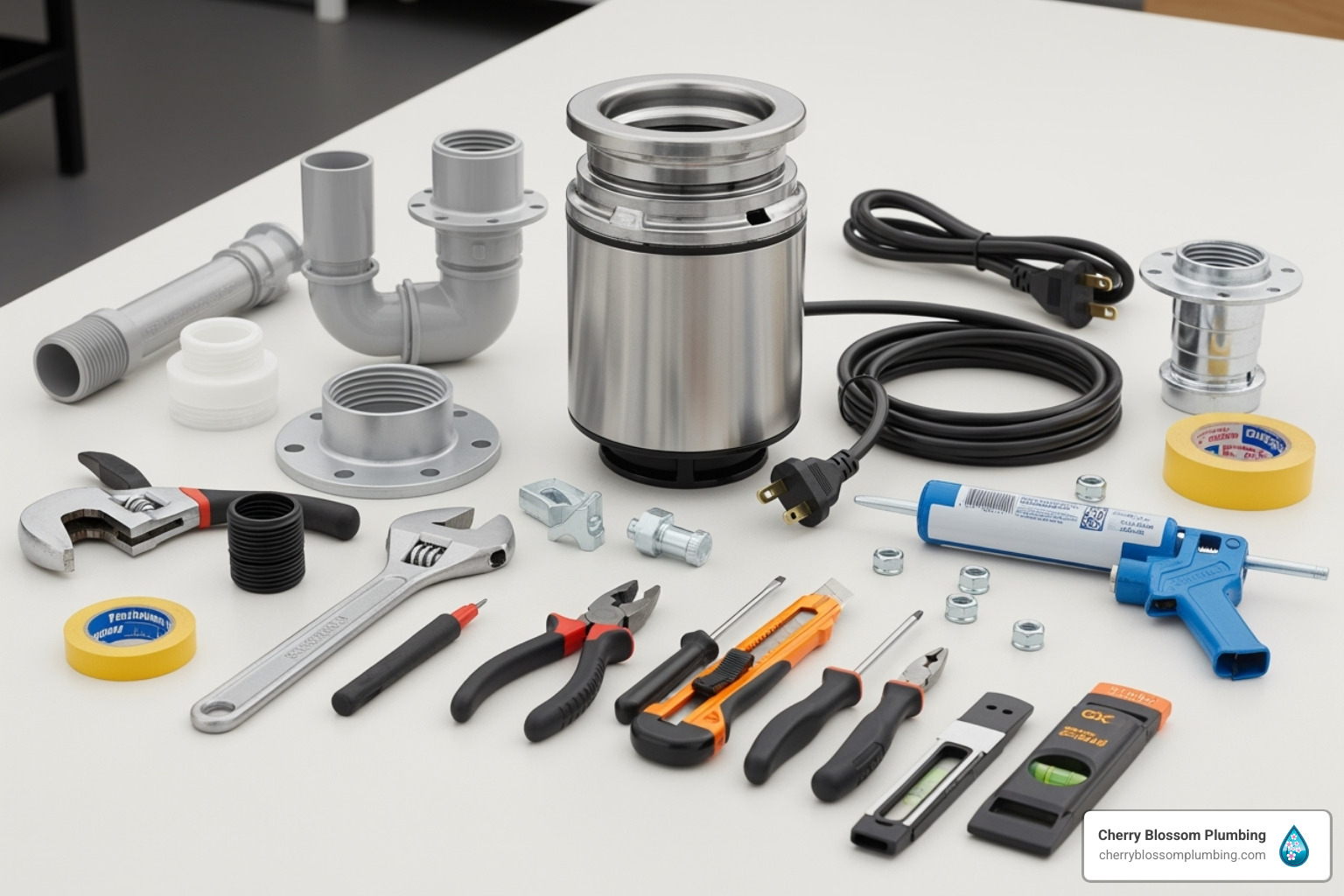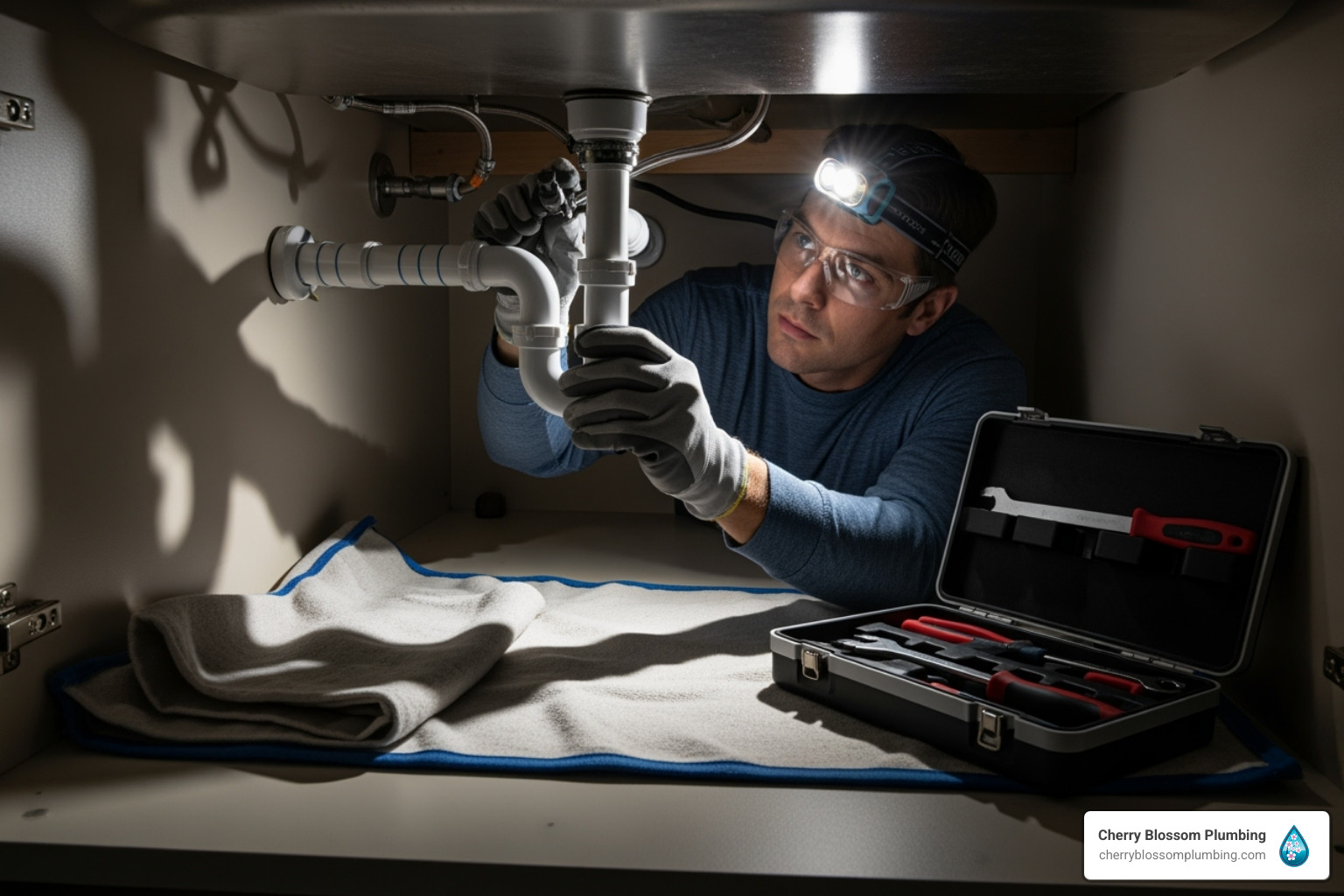Why Install a Garbage Disposal in Your Kitchen
Installing a garbage disposal can transform your kitchen cleanup and protect your plumbing from clogs. Here’s a quick overview of the process and benefits.
Quick Installation Overview:
- Turn off power at the circuit breaker
- Remove old disposal (if replacing) and disconnect drain pipes
- Install new sink flange with plumber’s putty and mounting assembly
- Wire the disposal connecting black-to-black, white-to-white wires
- Mount the unit and connect discharge tube to P-trap
- Test for leaks and proper operation
A garbage disposal cuts down on trash odors by disposing of food waste immediately, saves space in your trash by reducing the volume of organic waste, and provides an easy method for disposing of food scraps when composting isn’t an option.
Most homeowners can complete this project in less than 3 hours with basic tools and the right guidance. However, if you need electrical work like installing a new outlet or feel uncomfortable with any step, it’s wise to call a professional.
While it involves some heavy lifting and careful plumbing, the process is manageable for experienced DIYers with basic tools and safety gear.

Before You Begin: Tools, Materials, and Choosing Your Unit
Proper planning is key to a smooth garbage disposal installation. Gathering the right tools and choosing the correct unit beforehand prevents mid-project headaches and extra trips to the hardware store.
What to Consider Before You Install a Garbage Disposal
Choosing the right garbage disposal depends on your household needs and cooking habits. Here are the key factors to consider.
The Big Choice: Continuous Feed vs. Batch Feed
Continuous feed disposals are the most common type, operated by a switch. For homes with small children, a batch feed model offers improved safety, as it only runs when a special stopper is in place.
| Feature | Continuous Feed | Batch Feed |
|---|---|---|
| Operation | Food waste is added continuously while unit runs | Food waste is added in batches; unit runs only when stopper is in place |
| Control | Wall switch | Stopper activates the unit (magnetic or mechanical) |
| Safety | Requires more caution; can be activated accidentally | Safer, as objects cannot fall in while running; ideal for homes with children |
| Convenience | Faster and easier for large amounts of waste | Slower due to batch processing |
| Cost | Generally more affordable upfront | Often more expensive upfront |
| Installation | May require more complex electrical wiring (dedicated circuit) | Often has lower installation costs |
| Noise | Can be louder | Generally quieter |
Batch feed models are also generally quieter, which is a plus for open-concept kitchens.
Power Matters: Getting the Right Horsepower
More horsepower means better performance. A 1/3 HP unit is fine for soft scraps and light use. If you cook for a family, you’ll want at least 3/4 HP to handle tougher waste without jamming. For large households or serious cooks, 1 HP or higher units are workhorses that can grind almost anything, saving you frustration down the road.
Special Considerations for Your Home
If you have a septic system, you’ll need a disposal specifically designed for it to protect your tank’s natural processes. Also, pay attention to the grinding chamber material; stainless steel components resist corrosion and last longer. Many newer models also include noise-reduction features.
For more insights on why installing a disposal is worth it, check out Why Get Garbage Disposal Installation?.
Essential Tools and Materials
Gather these tools and materials before you begin to ensure the project goes smoothly.
Your Tool Arsenal
- Screwdriver set (Phillips and flathead)
- Adjustable pliers
- Hammer (for the dishwasher knockout plug)
- Safety glasses
- Voltage tester
- Wire strippers
- Putty knife
- Bucket and rags
- Hacksaw (if pipe adjustments are needed)
Materials You’ll Need
- New garbage disposal unit
- Power cord kit (if not included)
- Plumber’s putty
- Wire nuts
- Teflon tape
- Replacement drain fittings (if needed)
Being aware of common issues can help you avoid problems during installation. Take a look at Garbage Disposal Issues Homeowners Should Know to get ahead of potential challenges.
Having everything ready beforehand ensures you can complete the job without delays.
How to Install a Garbage Disposal: A Step-by-Step Guide
With your tools and new disposal ready, it’s time to begin. While learning how to install a garbage disposal may seem daunting, this step-by-step guide makes it a manageable DIY project. Prioritize safety as you follow these instructions to add convenience to your kitchen and protect your plumbing.
Step 1: Safety First & Removing the Old Unit
Safety is non-negotiable. Turn off power to the disposal at the circuit breaker. Use a voltage tester to confirm the power is off before touching any wires. It’s also wise to turn off the water supply valves under the sink.
To remove the old unit:
- Place a bucket under the P-trap to catch water.
- Use adjustable pliers to disconnect the drain pipes (P-trap and discharge tube) and the dishwasher hose (if applicable).
- Support the old disposal and use a disposer wrench (or large screwdriver) to turn the mounting ring counter-clockwise to detach it.
- Once the unit is free, disconnect the electrical wires by untwisting the wire nuts.
- Remove the old mounting assembly and use a putty knife to scrape away all old plumber’s putty from the sink drain for a clean surface.
For more detailed safety guidelines, check out our guide on Safe Garbage Disposal Installation.
Step 2: Install the New Sink Flange and Mounting Assembly
A proper seal is crucial to prevent leaks. Start with a clean, dry sink drain opening. Apply a 1/2-inch rope of plumber’s putty to the underside of the new sink flange.
Press the new flange firmly into the sink drain from above. From below the sink, slide the fiber gasket, backup flange, and mounting ring onto the flange’s tailpiece. Secure them by snapping the metal snap ring into its groove.
Tighten the mounting screws evenly and gradually, alternating between them to ensure even pressure. Excess putty will squeeze out around the flange in the sink; this is a good sign of a tight seal. Wipe away the excess.
Step 3: Prepare and Wire the New Disposal
Confirm the power is still off with your voltage tester. If you are not comfortable with wiring, call a professional. Remove the electrical cover plate on the new disposal.
Connect the power cord by matching the wire colors: white to white (neutral) and black to black (hot). Secure the green or bare copper grounding wire to the green grounding screw. Secure each connection with a wire nut.
If you need a visual guide for wire connections, this video is helpful: How Do I Connect Two Wires?
If you have a dishwasher, you must remove the knockout plug from the disposal’s inlet. Use a screwdriver and hammer to tap it out, then retrieve the plug from inside the grinding chamber. Your dishwasher will not drain if this plug is left in place.
Once wiring is complete, replace the cover plate. For expert assistance with professional installation, our team at Expert Disposal Installation for Waste is always ready to help.
Step 4: Mount the Unit and Connect the Plumbing
The final step is to mount the unit and connect the plumbing.
Lift the disposal and align its mounting lugs with the mounting ring. Rotate the ring clockwise until it locks securely into place.
Insert the rubber gasket into the discharge outlet and attach the discharge tube. Connect the tube to the P-trap and drain line. You may need a hacksaw to trim pipes for a perfect fit. Hand-tighten all slip nuts, then give them a quarter-turn with pliers. Use Teflon tape on threaded connections for extra leak protection.
If you have a dishwasher, connect its drain hose to the dishwasher inlet and secure it with a hose clamp.
For detailed information about dishwasher drain connections, this resource is invaluable: How to connect your dishwasher drain. And for a complete overview of the installation process, check out our comprehensive guide on Garbage Disposal Installation Steps.
Testing and Maintenance for Your New Disposal
After completing the installation, it’s time to test your work and learn key maintenance tips for long-term performance.
Final Steps to Install a Garbage Disposal and Test for Leaks
Follow these final steps carefully to ensure a leak-free installation.
- Inspect Connections: Double-check that all plumbing connections and the mounting ring are tight.
- Restore Power: Flip the circuit breaker back to the “ON” position and plug in the unit.
- Run Water: Turn on the cold water and let it run for 30 seconds. With a flashlight, check every connection for drips, especially the sink flange and pipe fittings.
- Test the Disposal: Turn on the disposal for a few seconds. Listen for a smooth, steady hum without rattling or grinding. Check for leaks again.
- Pressure Test: Plug the sink, fill it with an inch of water, then pull the plug. This rush of water will pressure-test the seals. If you see any drips, turn off the power and tighten the leaking connection. Repeat until everything is dry.
Long-Term Maintenance Tips
Follow these maintenance tips to keep your disposal running smoothly and prevent common issues.
- Use Cold Water: Always run cold water before, during, and for 15-20 seconds after use. Cold water solidifies grease and food particles, helping them flush away.
- Clean with Ice: Once a week, grind a handful of ice cubes to scrub the grinding chamber.
- Deodorize with Citrus: Grind lemon, lime, or orange peels to freshen the disposal naturally.
- Know What to Avoid: Never put fibrous foods (celery, corn husks), grease, oil, or fats down the disposal.
- Feed Scraps Gradually: Avoid overloading the unit by adding food scraps in small portions.
- Run it Regularly: Briefly run the disposal every few days to prevent rust and keep parts moving freely.
- Safety First: Never reach into the disposal. If it’s jammed, turn off the power at the breaker before using tongs or pliers to retrieve any objects.
For comprehensive guidance on keeping your disposal in top shape, check out our detailed tips on Maintaining Efficient Garbage Disposal Tips.
Frequently Asked Questions about Garbage Disposal Installation
Here are answers to common questions about how to install a garbage disposal.
How much does it cost to install a garbage disposal?
The cost to install a garbage disposal depends on several factors. A DIY installation only includes the cost of the unit and materials. Hiring a professional adds labor costs but ensures the job is done correctly and safely. Costs are affected by:
- The Unit Itself: Basic 1/3 HP models are more affordable than powerful 1 HP units.
- Labor: Professional installation includes the plumber’s expertise, licensing, and insurance.
- Electrical Work: A new outlet for a continuous-feed model will increase the total cost.
For expert repair and installation services, reach out to us at Garbage Disposal Expert Repair and Installation.
Are garbage disposal hookups and drain sizes universal?
Yes, garbage disposal hookups and drain sizes are largely universal. Most sink drains are a standard 3 1/2 to 4 inches, and disposal outlets are a standard 1 1/2 inches, fitting existing P-traps. Mounting systems are also fairly standard.
The main thing to check is the physical size of the unit. Disposals vary in height and width, so measure your under-sink cabinet space to ensure your chosen model will fit before you buy.
For professional guidance on choosing the right fit for your space, consider our expertise in Expert Garbage Disposal Installation.
When should I hire a professional instead of doing it myself?
While many homeowners can install a garbage disposal, hiring a professional is the smartest choice in certain situations:
- Electrical Work: If you need a new outlet or a GFCI outlet installed, you must hire a licensed electrician to ensure safety and code compliance.
- Complex Plumbing: If your pipes are old and corroded, or the new unit requires significant drain reconfiguration, a plumber has the tools and experience to prevent leaks and damage.
- Septic Systems: We strongly recommend consulting a professional to ensure your disposal is compatible with your septic system and installed correctly to avoid future problems.
- Lack of Time or Comfort: If you’re uncomfortable with any step, lack the right tools, or simply don’t have the time, calling a pro saves you stress. A DIY mistake can be more costly to fix than the initial professional installation.
For reliable garbage disposal repair and installation services, check out Garbage Disposal Repair and Installation.
Need an Expert Hand?
You now have a complete guide on how to install a garbage disposal. For many, this is a rewarding DIY project that makes kitchen cleanup faster and protects plumbing. There’s nothing like the satisfaction of a successful installation.
However, we understand that not everyone has the time or comfort level for this project. If you encounter complex plumbing, need new electrical work, or simply prefer a professional touch, our team at Cherry Blossom Plumbing is ready to help.
As a family-owned, licensed plumbing service in Arlington and Falls Church, VA, we pride ourselves on doing the job right the first time. We provide fast, reliable, and honest work with our signature “WOW factor” guarantee—no surprises, just straightforward, impressive service.
Our team serves the entire Northern Virginia area, including Arlington VA, Alexandria VA, Annandale VA, Fairfax VA, Falls Church VA, McLean VA, Oakton VA, Springfield VA, and Vienna VA. We handle everything from simple replacements to complex installations.
We bring the tools, expertise, and experience to get your new disposal running quickly and correctly, saving you time and worry.
Ready to upgrade your kitchen with professional help? For professional garbage disposal installation in Alexandria, VA, contact our expert team today! We’re here to make your kitchen cleanup dreams come true.




